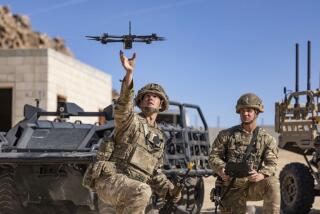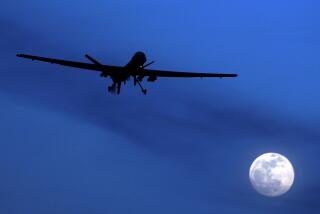Fly on Wall May Have an Engine
- Share via
BERKELEY — No machine, not even a $100-million jet fighter, can match the airborne prowess of a fruit fly.
The tiny insect can swerve into 90-degree turns that would rip apart any aircraft. It can bound into flight even with a large part of a wing missing. If blinded, it can navigate using its other sensors.
To a close fraternity of researchers, the fruit fly may hold the key to one of aviation’s boldest and perhaps most pesky challenges: to build tiny robotic airplanes known as micro air vehicles.
The speck-size fruit fly is the “most sophisticated flying animal in the world,” said Michael Dickinson, a leading expert on bug flight at UC Berkeley. “Unless you totally destroy it, it’ll get up and start flying again. If we can understand how they do that, I believe you can build almost anything better.”
Since Leonardo da Vinci first envisioned a mechanical bird, inventors have been preoccupied with building aircraft that can go higher and faster while carrying ever-larger loads.
That great ambition has produced super-fast planes such as the SR-71 spy craft and super-large passenger jets such as Airbus’ 555-seat A-380.
But now engineers are pushing in a radically different direction, trying to design aircraft so small that in a decade or less the proverbial “fly on the wall” may well become a technological reality.
All sorts of people are involved in the pursuit: college students tinkering with bat-like airplanes, professors studying hummingbirds, weapons developers and small aerospace firms looking for the next big product.
Proponents of micro aircraft say the uses for such vehicles are limited only by the size of a person’s imagination.
Some envision them following a golf ball, giving television audiences a bird’s-eye view of its flight. Others see them being used for more deadly purposes, such as carrying miniature bombs or toxins down the air vents of bunkers or caves.
Scientists at Caltech’s Jet Propulsion Laboratory in Pasadena even believe that micro air vehicles could help NASA explore Mars for signs of life. Others foresee a use in homeland security. A micro vehicle could be used as a video tracking device, following suspected terrorists or sniffing out potential chemical or biological threats.
For Pentagon strategists, tiny planes could help U.S. military personnel see individuals and small weapons hidden under trees or within buildings that spy satellites and the current generation of unmanned reconnaissance aircraft are unable to detect.
Pioneering research is being conducted locally at universities such as Caltech and UCLA and by companies such as AeroVironment Inc. in Simi Valley and Lockheed Martin Corp.’s super-secret Skunk Works laboratory in Palmdale.
Dickinson, for instance, will be moving his research from Berkeley to Caltech, where he says he will be able to tap some of the leading experts on aerodynamics.
One of the largest sources of funding for research into micro air vehicles has been the Pentagon’s Defense Advanced Research Projects Agency, or DARPA. For several years, the agency has quietly funneled hundreds of millions into micro air projects, including Dickinson’s fly research.
“We see a lot of utility in these small vehicles,” said Jan Walker, a spokeswoman for DARPA. She declined to say how many micro aircraft programs exist, because some are classified.
Developing tiny airplanes flies in the face of generally accepted laws of aerodynamics such as lift and drag.
These mini machines, measured in fractions of inches and ounces, should lack the power or maneuverability to stay airborne without floundering to the ground.
“Once you get below a certain speed and size, there is a serious degradation of aerodynamic efficiency,” said Peter Ifju, an engineering professor at the University of Florida, where students have been developing remotely controlled airplanes not much more than 4 inches long.
“Large birds can soar for long periods of time without flapping, but smaller birds and insects can’t do that, because the aerodynamics is degraded,” he said. “It’s another area of aerodynamics that we don’t know much about.”
Tantalizing clues are coming from nontraditional sources--from scientists such as Dickinson to an eccentric mix of engineering students who are tinkering with the latest advances in tiny batteries, propulsion systems and actuators.
Top engineering students from more than a dozen universities around the world gather every year to test some of the smallest planes ever built.
Aerospace engineers say the divergent fields of study are beginning to converge, raising prospects for the development of tiny airplanes that could not have been imagined just a few years ago. To some, the quest to build micro air vehicles is reminiscent of the chaotic days of powered flight at the turn of the 20th century.
“It’s a disruptive technology,” said Martin R. Waszak, senior aerodynamics engineer for NASA. “It can’t just come from study of engineered structures or just from study of biological structures. It will have to be an integration of a number of disciplines.”
Dickinson is a neurobiologist by training and began studying the aerodynamics of the fruit fly as a way to understand how the brain functions.
To do so, he has poked and prodded the insect and even subjected it to a battery of tests in flight simulators--albeit the size of coffee cans--that would make NASA astronauts envious. One of the simulators, attached to gimbals, twists and turns in response to minute fluctuations in the fly’s body movements.
First, Dickinson attaches a fly to a needle--a virtual science in itself: The fly is placed in a recessed bed that’s smaller than a grain of rice. The bed is lined with tiny holes that pull the fly’s body down with air suction and is cooled to immobilize the bug. The point of the needle is dipped in glue, then carefully attached to the body.
Once the fly is tethered to the head of the needle, Dickinson places it inside a circular chamber, where the insect is tricked into flying in a certain direction.
Electronic displays lining the inside of the chamber affect the bug’s view of the world by projecting different shapes and colors.
For instance, changing the position of a black vertical line displayed in the chamber prompts the insect to change its wing and body movements in the direction of the line.
A much more complex simulator dubbed the Rock & Roll Arena actually allows the fly to bank, yank and turn. The simulators, equipped with dozens of tiny sensors and cameras, have provided invaluable insight into how the insect flies.
Contrary to popular belief, flies flap their wings back and forth, not up and down, defying the old school’s theory about aerodynamics. When the wing flaps forward, it is angled sharply upward, which would cause most flying machines to stall and plummet to the ground.
But instead a fly creates a so-called delayed stall, a momentary swirl of air that it uses for lift as the wing rotates and goes over it backward.
It is, Dickinson said, essentially creating its own lift as it flaps back and forth an astounding 200 times a second.
To further study the bug’s flying capabilities, Dickinson has even built large mechanical replicas, dubbed Robofly and Bride of Robofly, that are immersed in 2-ton vats of mineral oil to simulate and understand what the tiny insects must be experiencing trying to fly. The air essentially feels gooey to flying insects, he says.
Ron Fearing, Dickinson’s colleague at Berkeley, is taking the research one step further and has designed a half-inch-tall robotic fly based on Dickinson’s research. He recently tested a tiny wing for the mechanical insect that flapped 150 times a second and generated enough thrust to move itself forward about a foot.
While Dickinson’s colleagues have been able to apply his work to design a rudimentary robotic fly, a cadre of engineering students has been constructing traditional fixed-wing airplanes that are pushing the limits of size from the other direction.
Last month, student engineers gathered for the sixth annual Micro Air Vehicle competition at a turf farm near Provo, Utah, to test their latest experiments.
Students from Brigham Young University won the endurance competition with a remotely controlled plane shaped like a bat and barely more than 4 inches long. When the competition began six years ago, the smallest plane was 30 inches long.
The miniature plane this year flew for more than 14 minutes, making sharp banks, dives and climbs before coming down within inches of its takeoff point. It was launched with a slight flick of the hand and carried an electric motor, not much bigger than a dime, that powered tiny propellers. It was constructed of foam and balsa wood and packed with a transmitter, receiver and tiny controls. It weighed slightly more than an ounce.
Another entrant with a tiny camera in its nose transmitted video images of a target nearly a mile away. The plane silently hovered, barely noticeable to anyone or anything except for a few curious swallows that flew by to investigate.
“In terms of pushing the envelope, this is cutting-edge stuff,” said John Asplund, an aeromechanical engineer at AeroVironment, an aerospace company that has pioneered the development of several airplanes including Helios, which holds the altitude record for a solar-powered aircraft.
The students’ work has been getting a lot of attention from the Pentagon, which sees potential applications including surveillance and carrying weapons.
There is an inherent advantage to small vehicles. They disappear from sight a few hundred feet above the ground and are hard to detect with radar. Even if they are detected, it’s often difficult to distinguish them from small birds or bats.
The Pentagon already is testing tiny autonomous airplanes to help an infantry unit, for instance, to see what’s behind a hill or what may be in a cave or a building.
Separately, some of the nation’s largest defense contractors also have begun research into micro air vehicles, though with little fanfare.
Engineers with Lockheed Martin, Boeing Co. and Raytheon Corp. are developing many variants of small, remotely controlled airplanes.
Many of the planes at the Utah competition were powered by tiny lithium batteries and electric engines that together can fit in a matchbox. The propellers are an inch or two long.
The students are creating leading-edge designs, NASA officials said. The agency sponsored the competition this year, hoping to glean from the micro air vehicle technology developed by the participants.
“We’re learning how these planes can be put together,” said David L. Raney, an aerodynamics and control engineer for NASA’s Langley Research Center in Virginia.
Joel M. Grasmeyer, an AeroVironment engineer who has developed several micro air vehicles for DARPA, says the students are doing work that is going further than the aerospace industry.
“In the next few years,” Grasmeyer said, “we’re going to see them make new developments that even NASA and DARPA will be able to learn from.”






